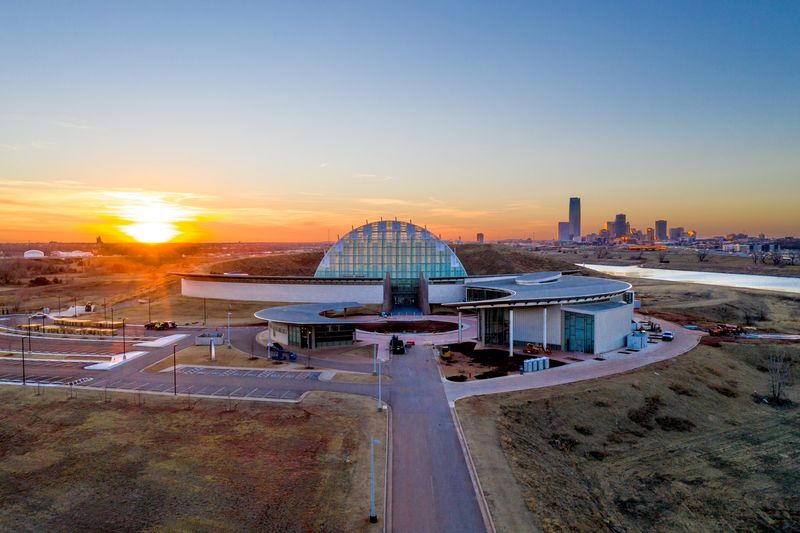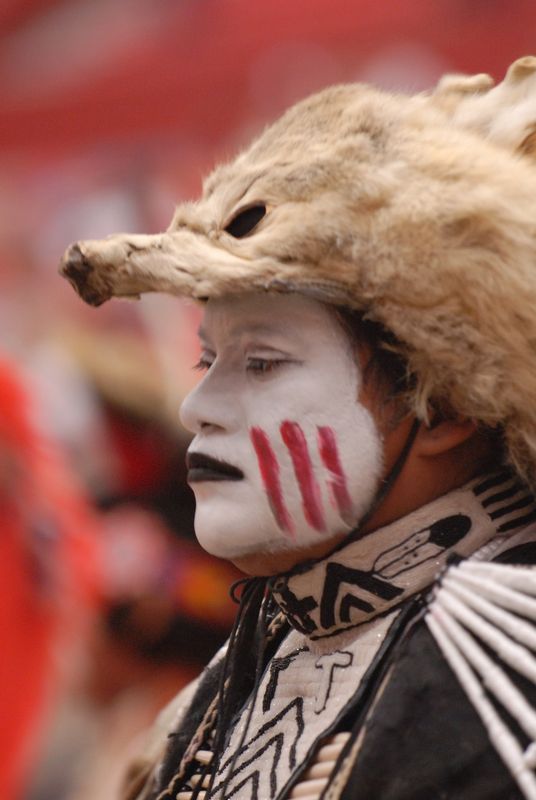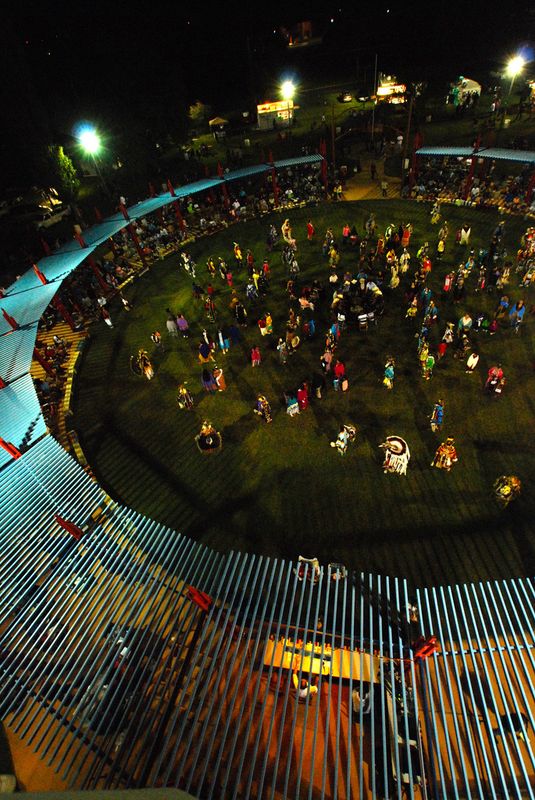A total of 67 Native American nations have called Oklahoma home. Here, discover the deeply held traditions and collective spirit of Native Americans in a way you won’t find anywhere else. Feel the heart-stopping power of a traditional tribal dance to a drum beat at a sacred powwow. Be swept away by the intricate details of colorful regalia at a parade and experience the deep peace and reverence of the earliest Oklahomans with a visit to one of many historical sites and centers that celebrate their rich tribal heritage.
First Americans Museum – Oklahoma City
Tucked between the Oklahoma River and downtown Oklahoma City, First Americans Museum visitors experience the collective histories of 39 distinctive First American Nations in Oklahoma today. Opened in 2021, this first-of-its-kind museum shares the collective diversity, history and contributions of the First Americans through hands-on activities and media-rich interactive displays. Okla Homma, the signature exhibition at the FAM, gives voice to the diverse stories of Oklahoman tribes. Stop by the cafe and coffee shop or indulge in a sit-down meal at the FAM Restaurant for a taste of Indigenous-inspired cuisine.
Choctaw Cultural Center – Durant
Follow the 14,000-year journey of the Choctaw people, discovering aspects of the tribe's story through immersive exhibits at the Choctaw Cultural Center near Durant. Come face to face with the Choctaw perspective on origins and creation stories, the Trail of Tears, and the modern Choctaw Nation. The story flows from ancestral times to the present through rich exhibitions, a café, an outdoor Living Village area and more, bringing the Chahta spirit of faith, family and culture to life.
Chickasaw Cultural Center – Sulphur
Immerse yourself in Chickasaw civilization from the tribe’s pre-Oklahoma existence through the triumphs of the tribe today at the Chickasaw Cultural Center in Sulphur. This grand cultural center, which sits on more than 100 acres of Chickasaw land in south-central Oklahoma, allows visitors to see, feel and even taste the heritage of the Chickasaw tribe through interactive exhibits, botanical displays and traditional dwellings.
Walk through the powerful Removal Corridor to view the painful journey that brought the Chickasaws to Oklahoma and feel as though you’re traversing the bleak winter landscape yourself. While at the center, join the inner circle of a long-practiced stomp dance and get a taste of true Chickasaw culture at the Aaimpa’ Café, where traditional fare such as grape dumplings, Indian fry bread and pashofa (a corn soup) are served.
Sequoyah’s Cabin – Sallisaw
Sequoyah, the famous Cherokee silversmith who developed the written alphabet for the Cherokee language, is memorialized on Oklahoma soil at Sequoyah’s Cabin in Sallisaw. Tour this one-room cabin, which Sequoyah built in 1829, and transport yourself to the days when Sequoyah worked to increase literacy within the Cherokee Nation. Learn the basics of Sequoyah’s working syllabary at the museum, where other Cherokee artifacts are also on display, and reflect on Sequoyah’s great accomplishment and contribution to Oklahoma heritage as you roam the very grounds Sequoyah once walked within the 10-acre park surrounding the cabin.
Spiro Mounds Archaeological Center – Spiro
On the long list of Oklahoma’s historical gems, the Spiro Mounds Archaeological Center in Spiro has earned its place near the top. Once the seat of power during the Mississippian period (circa 800-1500 AD), the Spiro people ruled over a confederation of more than 60 North American tribes, influencing trade, religion and the political structure of the southwest United States. Now open to the public, visitors are invited to tour the remaining artifacts of this mound-building culture and enjoy a spectacular view into ancient life. Learn about the burial mounds located here and how the Spiro people filled them with artwork, artifacts and other clues that serve as keys to unlocking the mystery behind their ancient civilization. Stand among the serene native grasses and view the mounds created by the Spiro Indians before you step into the center to view objects excavated from the “King Tut of the Arkansas Valley.”
Five Civilized Tribes Museum – Muskogee
Step into the Five Civilized Tribes Museum in Muskogee and you will be standing on a piece of sacred American Indian history. While the museum is packed with one-of-a-kind art and artifacts celebrating Native American life, the building itself plays a significant role in the history of the tribes. As the first Union Indian Agency building to house the Superintendence of the Five Civilized Tribes (Cherokee, Chickasaw, Choctaw, Muscogee and Seminole), this museum is uniquely able to convey the rich culture and heritage of the tribes. Visitors are invited to view breathtaking artifacts, paintings and sculptures that depict the American Indian journey that has been both painstaking and celebratory.
Standing Bear Park, Museum & Education Center – Ponca City
Standing Bear may have been a chief of the Ponca tribe, but the towering statue erected in his honor in Ponca City stands as a tribute to every Native American. Famous for his landmark speech before a U.S. District Court in 1879 stating that all American Indians regardless of tribe deserved the same recognition and protection under the law as white men, Standing Bear paved the way for native rights in this country. Standing two stories high and made of bronze, this larger-than-life representation of the chief at Standing Bear Park captures his spirit of compassion and zeal.
After viewing the statue of Standing Bear, take a moment to stroll along the on-site walking trails and consider the incredible legacy of the six area Native American tribes: Osage, Pawnee, Otoe-Missouria, Kaw, Tonkawa and Ponca. Don’t miss the renowned Standing Bear Powwow, held each year in September, to witness as representatives from these six tribes gather for intertribal dancing, powerful singing and lively drumming within the park.

























































